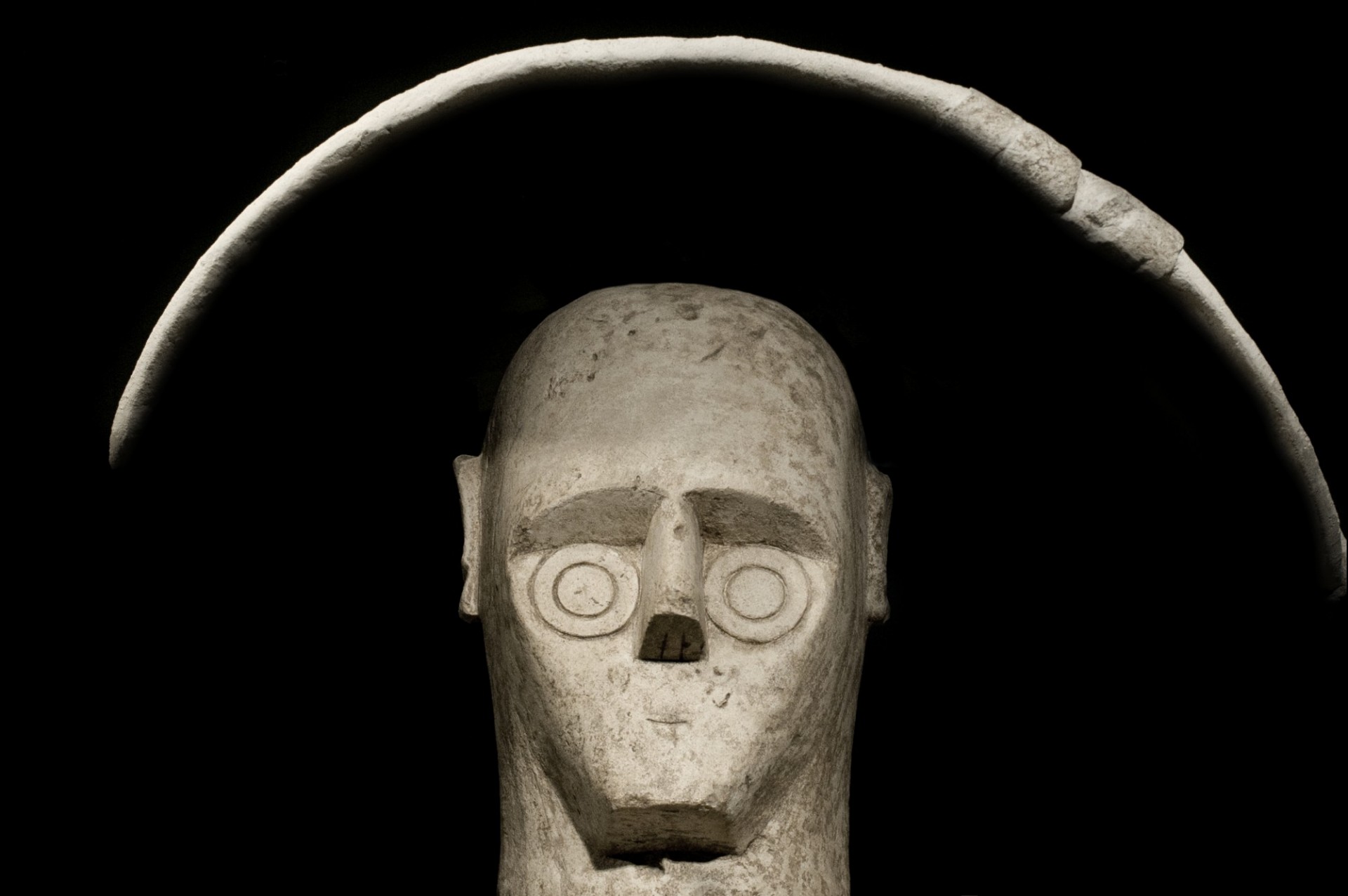By Emerenziana Usai, Archaeologist, Superintendency of Archaeology, Fine Arts and Landscape for the Metropolitan City of Cagliari and Provinces of Oristano and South Sardinia (Sardinia)

In a remarkable recent discovery at Mont’e Prama, two sculptures came to light holding elongated, enveloping shields—not unlike the bronze statue of a boxer priest from an Etruscan necropolis on the mainland of Italy.
Timeline
The extraordinary tale of Mont’e Prama’s rediscovery began when a farmer, Sisinnio Poddi, was plowing in Cabras, on March 28, 1974, and found a large head and other stone sculptural fragments. What followed were decades of intense and dedicated excavation, research, and restoration.
1975
The first scientific excavation in the Mont’e Prama area was done by Alessandro Bedini, the inspector of the Superintendency of Cagliari. The brief excavation (December 3–16) brought to light a small part of the early Iron Age necropolis with pit tombs: seventeen of these had a simple pit covered with small stones, and twelve had a pit topped by a small square sandstone slab. In each tomb the deceased was huddled in a seated position, without any grave goods.
1976–1977
In August 1976 the archaeologist Giovanni Lilliu linked the stone sculptures to Nuragic bronze statuettes, judging them to be representations of ancestor heroes connected to a Nuragic quadrangular temple. Shortly afterward, excavations by Carlo Tronchetti and Maria Luisa Ferrarese Ceruti brought excellent results: twelve headless torsos were found, along with three heads, numerous fragments of arms and legs, and a foot with a statue base, as well as architectural capitals and arches. Most significantly, the team identified a sequence of sandstone slabs arranged along the north–south axis, interpreted as the base of a temple.
1979
The results from 1977 led the Superintendency to plan a large excavation campaign. Funding from the Ministry of Cultural and Environmental Heritage permitted archaeological investigation at Mont’e Prama from July 2 to October 12, 1979. The campaign was directed by Carlo Tronchetti, with Paolo Bernardini, Raimondo Zucca, and this author, Emerenziana Usai. Thirty individual pit tombs were brought to light, each covered by a square slab of sandstone.
Osteological analysis on twenty-eight buried subjects determined that most were males, no older than twenty-five years, and none of them infants.
Radiocarbon analysis on the bones helped to define the chronology. East of the slab tombs, a simple pit burial covered only by small stones yielded a dating between 1089 and 900 BCE; two burials among the slab-covered tombs dated to the Iron Age. The more recent tombs of Mont’e Prama—and, consequently, of the sculptures—date to the second half of the ninth century and the early decades of the eighth century BCE, and this is corroborated by the comparison of the stone statues with Nuragic bronzes.
2005–2011
In 2005 the 5,178 sculptural fragments found at Mont’e Prama were transferred to the well-equipped Conservation and Restoration Center in the city of Sassari. The restoration was done by Roberto Nardi of Rome’s Archaeological Conservation under the scientific direction of Antonietta Boninu. Twenty-eight sculptures were restored: sixteen boxers, six archers, and six warriors, along with twelve nuraghe models and one baetyl. They were exhibited in Sardinia at the museums in Cagliari and in Cabras.
2014
![Image: Archaeological Superintendency [A. Usai, E. Usai]; University of Sassari [R. Zucca, P. Bernardini, P. G. Spanu]; University of Cagliari [G. Ranieri]. Photo: Ivan Lucherini Aerial view of tombs](/sites/default/files/styles/cu_crop/public/content/pics/19.%20Usai.jpg?itok=M3T7apoJ)
Work resumed in 2014 thanks to the “Archaeology of Mont’e Prama” project developed by the Universities of Sassari and Cagliari, which included a geophysical report, landscape archaeology analysis, and archaeological excavation. The ten-month investigation depended partly on work by university students; four inmates from the nearby Massama prison also took part, thanks to a prison training course on archaeology and research methods.
The most striking event of the 2014 excavation—which revealed two baetyls and a limestone floor—was the recovery of two sculptures with unexpected iconography: statues of a figure whose right arm touches an elongated and enveloping shield supported by his other arm. These items are similar to the iconography of the male bronze statue of a boxer priest from Cavalupo, an Etruscan necropolis in Vulci (in central Italy).
2015-2021
![Image: Archaeological Superintendency [A. Usai, E. Usai]; University of Sassari [R. Zucca, P. Bernardini, P. G. Spanu]; University of Cagliari [G. Ranieri]. Photo: Gianni Romano; Relief: Luciana Tocco Aerial view of pit tombs; relief diagram](/sites/default/files/styles/cu_crop/public/content/pics/20.%20Usai.jpg?itok=kNj2WGV8)
As the work progressed, the archaeologists found eight simple pit tombs to the east (covered with small stones), and eight other pit tombs to the west (covered with slabs). This photo shows the baetyls after they were uncovered, as well as the two Cavalupo-type boxers in the lower left corner (at the southwest).
Alessandro Usai, of Cagliari’s Archaeological Superintendency, intervened to recover, restore, and expand Bedini’s and Tronchetti’s trench, which crosses the entire piece of land. With the excavation campaign of 2015–2016, a large circular Nuragic building (A), a small adjacent room (B), and a third room (C) were investigated in the southwestern sector.
In September–October 2017, Alessandro Usai and Raimondo Zucca excavated the southern section of the necropolis where the walkway of the funerary road was revealed, leading to publications up through 2021 about the extent of the site.
Two bioarchaeologists at work in excavation
